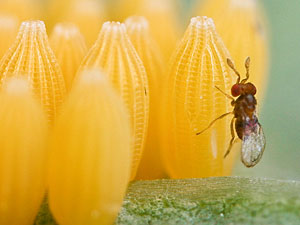
Parasitic wasp hitching a ride on the face of a moth
The parasitic wasp (Dicopomorpha echmepterygis) is the smallest flying creature in the world with a length of approximately 0.1mm-0.17mm and a weight of only 0.000025 grams. It typically serves as a biological crop protector by killing the eggs from which harmful caterpillars grow. The wasp is technically a parasitoid because while parasites live off the expense of their host without actually killing it, parasitoids almost always kill their host. It is known that these insects are “hitchhikers” and often ride on the faces of butterflies and larger insects to travel. However, until recently, nobody knew exactly how these insects were able to get to their hosts and their hosts’ eggs.

Parasitic wasp on butterfly eggs
The “Flight Artists” from Wageningen University in the Netherlands were the first to film the flight of the parasitic wasp on a high speed camera. Only 54 people have been trained to take this extraordinary camera into the field. The videos prove that these tiny insects are in fact capable of flight and allow us to analyze their flight techniques. They use a combination of both leaping and flapping to generate enough lift for flight. First they use their tiny legs to jump. Once they are in the air, they must flap their wings at an incredibly fast rate of 350 times per second. The parasitic wasp beats its wings 14 times in the time between two TV images. The video shows that they are capable of independent controlled flight. However, it seems that the insect has not mastered the landing process yet. Whether it is landing on its feet or boldly on its head, the parasitic wasp is almost always in store for a crash landing.
4 Comments
Lorena Barba posted on October 12, 2011 at 11:05 am
Wow, Christopher, that is a really cool video!
(I embedded it on the post.) They are so small that they seem to be moving in a very viscous fluid, rather than air. And when they fall head-first, it’s hilarious!
Nathan Provencher posted on October 12, 2011 at 4:34 pm
I agree Christopher this is an amazing creature; very interesting. Great post!
Shahil Patel posted on October 14, 2011 at 4:18 pm
the pictures you posted are really nice. I liked the description of how they start their flight.
Lorena Barba posted on October 23, 2011 at 8:20 pm
To clear some confusion — the smallest parasitic wasp ever seen is indeed the D. echmepterygis, measured at 0.139 mm (in the case of the wingless male).
http://entnemdept.ufl.edu/walker/ufbir/chapters/chapter_38.shtml
The parasitic wasp shown in the video, however, is a Trichogramma, measuring 1 mm in wingspan and weighing 0.000025 g.